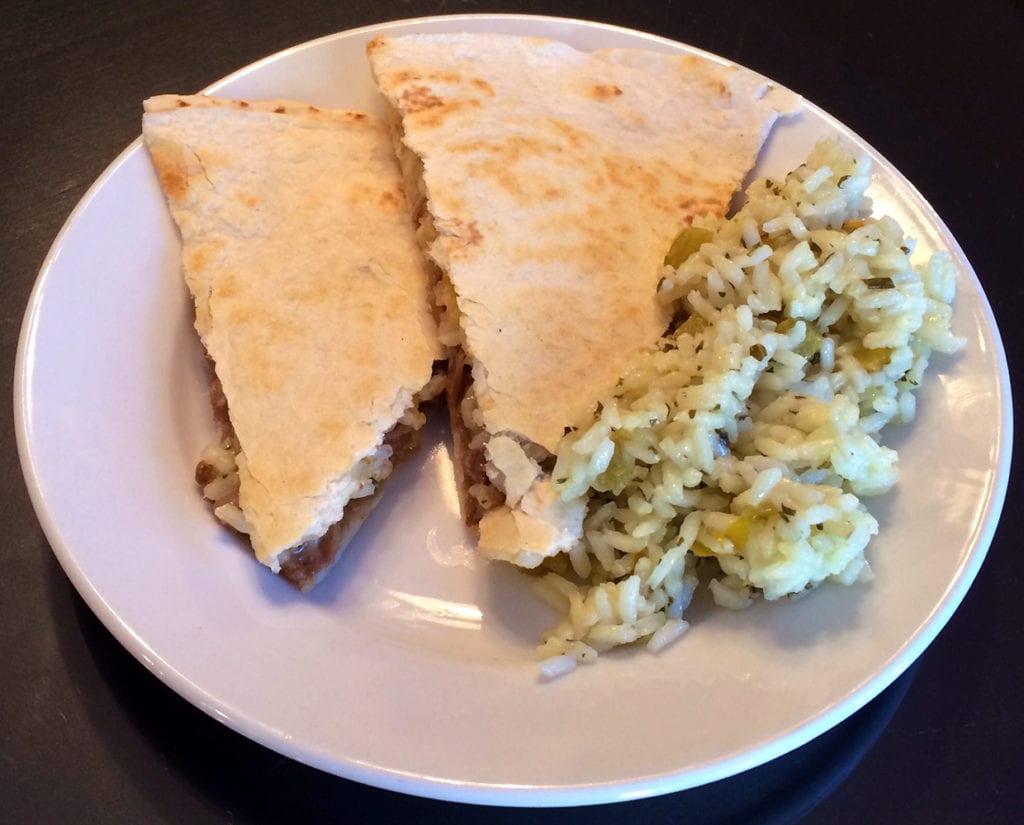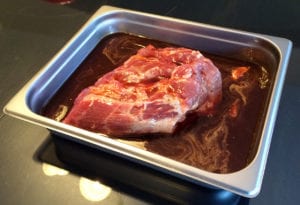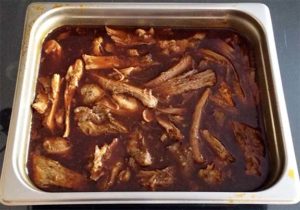Boston butt or pork butt is the American name for a cut of pork that comes from the upper part of the shoulder from the front leg and may contain the blade bone. Boston butt is the most common cut used for pulled pork. Despite the name, it does not come from the pig’s rear end.
Okay…I will admit I never used to be much of a pork fan. Before you gasp in horror, let me explain! When I was growing up, my folks served pork chops that were thrown on a dry frying pan for probably 25 minutes per side, and I honestly think shoe leather would have been easier to eat! This is one food memory I simply cannot forget.
That was then. Now I have CVap on my side, and I’ll never have to eat a dried-out, chewy piece of pork again.

Let’s get down to business. I wanted to create a tender, moist, sweet piece of pork that I could shred for quesadillas. In this case, I made a small roast to feed a few people. If you are feeding the masses, simply increase portion size. I used pre-packaged ingredients for convenience, but you can experiment with flavor combinations. I have two hungry boys at home (one of whom eats so fast I wonder if he can taste his food!) and they both love this recipe and ask for it repeatedly.
Ingredients
- Pork Butt Roast (approximately 3 – 3.5 lbs.)
- 1 Old El Paso Sauce Packet (Roasted Garlic)
- 1 Cup A&W Root Beer
- 6 oz. Tomato Paste
- ½ Cup Chicken Broth
- 2 Cups Light Brown Sugar


Instructions
- Preheat CVap Cook and Hold Oven to Vapor 175°F/Air 205°F
- Place pork in the steam table pan.
- Mix all the ingredients in a separate bowl and pour over the pork.
- Put into the CVap oven. Set cook time for 6.5 hours, and hold for 150°F, infinite. Push start, and walk away.
At this setting, the oven will hold at 150°F when the cook cycle is complete. Following the cook cycle, I usually shred the pork and put it back into the oven for approximately 1.5 hours before serving. It always turns out great! Sweet flavor all the way through and perfect texture. Accompany the pork with some black beans and cilantro lime rice, and the family is well on its way to full and happy bellies. If you’re not a fan of pork butt, this recipe will make you a believer!

Fun Facts About Pork Butt
The pork butt is a moderately tough cut of pork with lots of connective tissue.
The name makes sense when you consider that the word “butt” can also mean the thicker end of something (like the butt of a gun) or the blunt end of something since a pork butt is the thicker end of the shoulder cut. Pork butt cuts are relatively inexpensive, compared to some other pork cuts.
How to Cook Pork Butt
Pork butt does best with long, slow cooking, which is why CVap ovens are so ideal. Butts are great choices for barbecuing, braising, and stewing. They stand up well to strong flavors because they have a strong flavor themselves. This is because the meat is derived from a hard-working section of the pig. Carrying around all the weight exercises that portion and results in it developing great flavor. This is especially true of pastured pigs raised in environments where they can walk around.
What Does Butt Taste Like?
Sorry, couldn’t resist that heading. The fat content in pork butt gives it more flavor and naturally bastes the meat. Long, slow cooking on low heat brings out the juices and makes for a tender, more succulent cut of meat. The low heat breaks down the connective tissue, slowly dissolving it away. That’s why pork butt benefits from holding in a CVap for a while after the cooking cycle is complete. The low heat just keeps making the butt more tender (and tasty).
You can, if necessary, use a pork butt and pork shoulder interchangeably in most recipes. Pork shoulder is a bit better if the final plan is to slice or chop the meat and have it hold its shape, while the more intense marbling of pork butt makes it particularly well suited for barbecue, specifically making pulled pork or other recipes where you want the meat to fall apart into shreds easily.

Why is it Called Boston Butt?
Pork butt is sometimes called Boston butt. Why? Like a lot of food terms, there’s a bit of debate. One theory was that it referred to the barrels used to ship pork products from Boston. But then, Boston was never really a center of pork production, so that theory doesn’t really hold up. It’s much more likely that as the term came to be accepted as railroads made standard cuts more widely accepted. Think New York strip or St. Louis ribs. In that context, Boston butt makes more sense.





